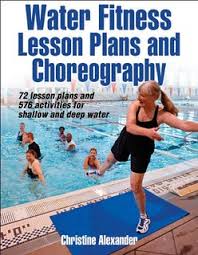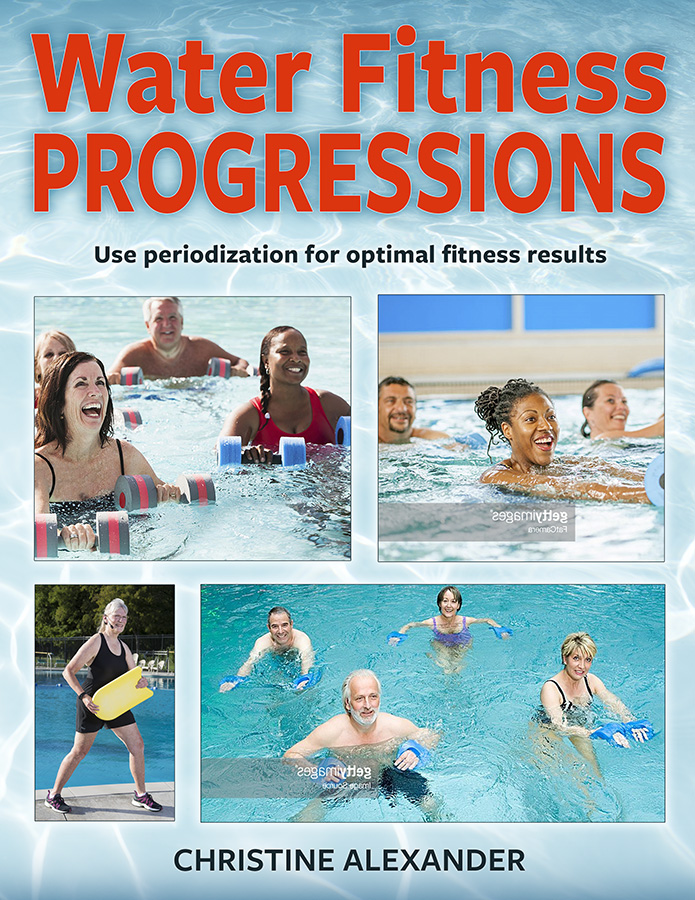
All exercise is properly performed with the spine in neutral alignment. In deep water, good posture is more challenging to achieve because the feet do not touch the floor. Beginning exercisers may find themselves curling forward, flailing the arms, and drifting. There are some things you can do to stabilize. The most important is to wear a deep-water flotation belt. Without it, you will find yourself sinking when you attempt to achieve upright neutral alignment. Use a stabilizing scull, sweeping the hands in and out, to control flailing and reduce drifting. Webbed gloves further increase stability. Learn to brace the core muscles. Include tucks in the warm up (tuck ski or jacks tuck) to engage the core. With practice, the core muscles will engage continuously and discreetly throughout the workout, which is why deep water exercisers so often see improvements in their posture. Below is a list of basic deep water exercises with descriptions. Click on the name of the exercise to see a short video demonstration.
Scull. Sculling is an important skill in deep water. Besides assisting in stabilization, you can use a propeller scull (a figure 8 hand motion) to travel. Hold the hands up in front of you and propeller scull to travel backward. Hold the hands down by your sides and propeller scull to travel forward. Extend the hands out to the sides and use the scull to lift the shoulders out of the water. This works great with jog, heel jog, bicycle, and flutter kick. Maintain the elevation for 30 seconds or more to up the intensity.
Knee-high Jog, Sprint, and Power Run. Jogging is one of the most basic of all moves. Lift the knees until the thighs are parallel to the floor in a knee-high jog. Lifting the knees higher than that tends to make you curl forward and puts a strain on the low back. To increase intensity, go into a sprint by adding speed. To increase intensity even further, go into a power run, which uses large, powerful arm movements that pull the water, and longer, more powerful leg movements.
Heel Jog. Instead of lifting the knees in front, heel jog lifts the heels in back, working the hamstrings. Check to make sure that the knees are staying down.
Skate Kick. A kick backward with straight legs works the gluteus maximus, a muscle that tends to be weaker from sitting too much. Watch that you are not bending the knees and turning the exercise into a heel jog.
Crossover Kick. The midline of the body is an imaginary line that goes through the nose and the bellybutton. Crossover kick crosses that midline. Since the right side of your brain controls the left side of your body, and the left side of the brain controls the right side of your body, crossing the midline of your body requires using both brain hemispheres, causing more neurons to fire and making more connections. It’s a good idea to include some exercises that cross the midline in every session.




Skate Kick, Crossover Kick, Sweep Out and Center. I love this exercise! It challenges coordination, crosses the midline, and engages the core. One leg kicks back, then kicks across the midline, sweeps out to the side and returns to center. Perform the move alternating right and left legs.
Cross-country Ski. Cross-country ski is the ultimate deep water exercise! It uses long levers, works both the upper body and the lower body, and gets the heartrate up. Plus, there are multiple variations! In a neutral position the arms and legs should go forward and backward evenly. If the glutes are weak, it may be difficult to get full hyperextension of the hips. If you tilt the trunk back and focus too much on hip flexion, you end up just kicking forward. Check out your form by skiing with your back to the pool wall; your heels should tap the wall. Try shortening your range of motion so that your forward flexion is not greater than your backward hyperextension. As the glutes get stronger you can increase your range of motion.
Cross-country Ski Travel Backward and Forward. Traveling backward with cross-country ski is a challenge. You cannot propel yourself backward by pushing off the floor. Instead your push yourself backward with a powerful forward arm swing. This takes upper body strength! Turn your palm to face forward when you swing the arm forward, and slice on the swing backward. Do the opposite to travel forward. Turn the palm to face back when the arm swings backward, and slice when the arm swings forward.
Tuck Ski. Instead of tucking your knees up, tuck your feet under your body. That way when you go into the ski your flexion (with the front leg) and hyperextension (with the back leg) will be equal. Watch that you don’t power pop the knees when you lengthen the legs. Tuck ski is a good exercise for the warm up or for active recovery between intervals.


Cross-country Ski with Rotation. This is another exercise that crosses the midline of the body. The rotation is in the upper body, and therefore the arms reach across the midline, while the legs move toward the corners. This is a difficult exercise for some people to master. They end up doing a crossover kick while sweeping both arms side to side, or a crossover kick reaching with the arm on the same side of the body. It looks and feels awkward. But once the move is mastered, you can really up the intensity because the range of motion is so large, the movement is in multiple directions, and you are creating lots of turbulence.
Cossack Kick. My class likes this move. Begin with the heels together and the knees apart, in a diamond position. The shoulder blades are contracted with the elbows bent and the hands out to the sides, thumbs up. Now kick the legs out to the sides and at the same time reach the arms out to the sides. It looks a little like a marionette dancing.
Jumping Jacks. If you perform jumping jacks in deep water the same way you perform them on land, you will find yourself bobbing up and down. Performing them with arms and legs opposite solves the problem. Think of making a capital letter T with your body followed by a capital letter A.
Jumping Jacks Travel Sideways. If you want to travel sideways with jumping jacks you need a different arm and leg motion. Use only one side of your body. If you are traveling to the right, your right arm and right leg reach out to the side, then pull them both straight to center. Use the left arm and leg to travel to the left. Be sure to keep the leg straight, working the inner thigh. A common mistake is bending the knee, since short lever moves are easier than long lever moves. But this turns the move into a Cossack kick and works the hamstrings instead of the inner thigh.
Jacks Tuck. For this exercise tuck your knees up and bring your arms down to the sides. Then abduct the hips (bring the legs out to the sides) while lifting your arms to the side toward the surface of the water. Jacks tuck is another good exercise for the warm up or for active recovery between intervals.
Inner Thigh Lift. Begin with your legs wide apart. Lift one inner thigh toward the surface of the water while the opposite hand reaches down to touch the inner thigh. You can also touch the lower leg or even the ankle if you can reach it, but watch that you do not lean forward to accomplish this. It is more important to keep the spine in neutral than to touch the ankle. Work in your feel good range of motion. It is okay to bring the legs closer together if wide apart is uncomfortable for you, but if the legs are too close together the exercise becomes a knee-high jog.
Accelerate the Legs to Center Elevating the Shoulders. Elevation is a power move that begins with the legs apart, either front to back or side to side, followed by a forceful acceleration of the legs to center. As the straight legs come together the shoulders lift out of the water. There are four exercises that use this technique: cross-country ski with elevation, tuck ski together, frog kick, and breaststroke kick. All of them are great exercises to use in interval training.


Cross-country Ski with Elevation. Use your full range of motion for this ski, then forcefully pull the straight legs to center. Repeat. Repeat. Repeat.
Tuck Ski Together. Begin by tucking the feet under your body before going into a full range of motion ski then bringing the straight legs to center. Add some speed and perform the move smoothly. If you are a swimmer you will recognize this as a vertical scissors kick. For non-swimmers, a common mistake is going back into a tuck before the straight legs come together; this takes the power and elevation out of the move.
Frog Kick. This is another move swimmers will be familiar with. Begin by lifting the knees wide to the sides. Straighten the legs into a full range of motion jacks position. Then forcefully accelerate the straight legs to center. Again, a common mistake is tucking the knees back up before the straight legs come together, and then the move is essentially a jacks tuck.
Breaststroke Kick. Instead of lifting the knees wide to the sides as in the frog kick, lift the heels up in back. Then straighten the legs into a full range of motion jacks position and forcefully accelerate the straight legs to center. Both the breaststroke kick and the frog kick are lateral moves, but in the breaststroke kick the legs lift in back first and in the frog kick the knees lift to the sides first.
Side to Side. Begin by tucking your feet under you. Then extend both legs to one side in a side-lying position. Tuck again and extend both legs to the other side. Try to keep the feet close together. Foam dumbbells held out to the sides assist with stabilization for this exercise. It can be performed without dumbbells; in that case stabilize with a scull.
Abdominal Pike and Spine Extension. This is my favorite move for working the abdominals and erector spinae. Begin by tucking your feet under you. Then go into a pike, or a capital letter “L” position. Tuck again and extend both legs 45 degrees to the back. Try to keep the feet close together. Foam dumbbells held end to end on the surface of the water assist with stabilization; keep them on the surface of the water and let your abdominals do the work. This exercise can be performed without dumbbells; in that case stabilize with a scull.




Burpees. This is a fun move! You need to use a noodle, preferably one of the denser more buoyant ones. Begin in a plank position. Tuck the feet under you and then drop the legs down to neutral, letting the noodle rise toward the surface. Push the noodle back down and flutter kick to lift the shoulders out of the water. Tuck your feet under you again and go back into a plank position.
Once you get comfortable in deep water you can really get a great workout. I enjoy the freedom of moving without my feet touching the floor. The late John Spannuth, the founder of the US Water Fitness Association, compared deep water exercise to flying. If you would like to know more about deep water exercise, check out my books. Water Fitness Lesson Plans and Choreography has lots of photographs and cues that tell you what muscles you are working. Water Fitness Progressions tells you how to progress your exercises from basic to high intensity interval training, plus lesson plans using various types of equipment.
See you in the deep end!



